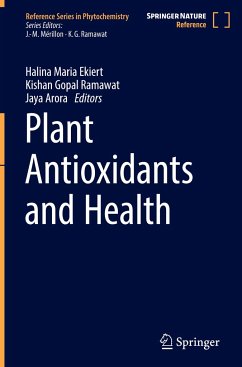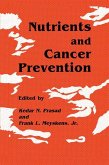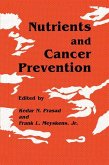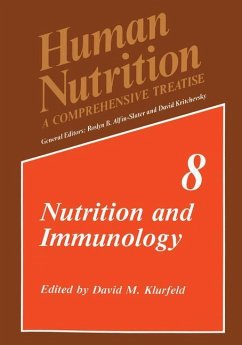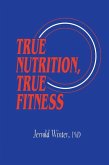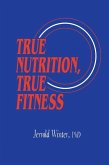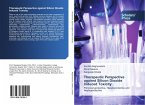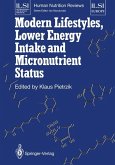Plant Antioxidants and Health
Herausgegeben:Ekiert, Halina Maria; Ramawat, Kishan Gopal; Arora, Jaya
Plant Antioxidants and Health
Herausgegeben:Ekiert, Halina Maria; Ramawat, Kishan Gopal; Arora, Jaya
- Gebundenes Buch
- Merkliste
- Auf die Merkliste
- Bewerten Bewerten
- Teilen
- Produkt teilen
- Produkterinnerung
- Produkterinnerung
This book provides a comprehensive reference guide to plant-derived antioxidants, their beneficial effects, mechanisms of action, and role in disease prevention and improving general health (anti-ageing effect).
The content is divided into three main parts, the first of which covers various antioxidants (such as polyphenols, carotenoids, tocopherols, tocotrienols, glutathione, ascorbic acid), their origins, plant biochemistry and industrial utilization. In turn, the book's second, main part focuses on antioxidants' beneficial health effects, explains biochemical fundamentals such as the…mehr
Andere Kunden interessierten sich auch für
![Nutrients and Cancer Prevention Nutrients and Cancer Prevention]() Kedar N. PrasadNutrients and Cancer Prevention77,99 €
Kedar N. PrasadNutrients and Cancer Prevention77,99 €![Nutrients and Cancer Prevention Nutrients and Cancer Prevention]() Kedar N. PrasadNutrients and Cancer Prevention77,99 €
Kedar N. PrasadNutrients and Cancer Prevention77,99 €![Nutrition and Immunology Nutrition and Immunology]() Nutrition and Immunology77,99 €
Nutrition and Immunology77,99 €![True Nutrition, True Fitness True Nutrition, True Fitness]() Jerrold WinterTrue Nutrition, True Fitness38,99 €
Jerrold WinterTrue Nutrition, True Fitness38,99 €![True Nutrition, True Fitness True Nutrition, True Fitness]() Jerrold WinterTrue Nutrition, True Fitness38,99 €
Jerrold WinterTrue Nutrition, True Fitness38,99 €![Therapeutic Perspective against Silicon Dioxide Induced Toxicity Therapeutic Perspective against Silicon Dioxide Induced Toxicity]() Suchita RaghuvanshiTherapeutic Perspective against Silicon Dioxide Induced Toxicity39,99 €
Suchita RaghuvanshiTherapeutic Perspective against Silicon Dioxide Induced Toxicity39,99 €![Modern Lifestyles, Lower Energy Intake and Micronutrient Status Modern Lifestyles, Lower Energy Intake and Micronutrient Status]() Modern Lifestyles, Lower Energy Intake and Micronutrient Status77,99 €
Modern Lifestyles, Lower Energy Intake and Micronutrient Status77,99 €-
-
-
This book provides a comprehensive reference guide to plant-derived antioxidants, their beneficial effects, mechanisms of action, and role in disease prevention and improving general health (anti-ageing effect).
The content is divided into three main parts, the first of which covers various antioxidants (such as polyphenols, carotenoids, tocopherols, tocotrienols, glutathione, ascorbic acid), their origins, plant biochemistry and industrial utilization. In turn, the book's second, main part focuses on antioxidants' beneficial health effects, explains biochemical fundamentals such as the free radical theory and oxidative stress, and discusses antioxidants' role in e.g. cancer, cardiovascular diseases, inflammation, degenerative diseases and ageing. The third part reviews general laboratory methods for antioxidant screening, preservation and determination.
Written by an international team of experts, this highly interdisciplinary book will benefit a broad range ofhealth professionals and researchers working in biochemistry, biotechnology, nutrition, plant science and food chemistry. It offers an indispensable, up-to-date guide for anyone interested in antioxidants and the role of a plant-based diet in disease prevention and control
Hinweis: Dieser Artikel kann nur an eine deutsche Lieferadresse ausgeliefert werden.
The content is divided into three main parts, the first of which covers various antioxidants (such as polyphenols, carotenoids, tocopherols, tocotrienols, glutathione, ascorbic acid), their origins, plant biochemistry and industrial utilization. In turn, the book's second, main part focuses on antioxidants' beneficial health effects, explains biochemical fundamentals such as the free radical theory and oxidative stress, and discusses antioxidants' role in e.g. cancer, cardiovascular diseases, inflammation, degenerative diseases and ageing. The third part reviews general laboratory methods for antioxidant screening, preservation and determination.
Written by an international team of experts, this highly interdisciplinary book will benefit a broad range ofhealth professionals and researchers working in biochemistry, biotechnology, nutrition, plant science and food chemistry. It offers an indispensable, up-to-date guide for anyone interested in antioxidants and the role of a plant-based diet in disease prevention and control
Hinweis: Dieser Artikel kann nur an eine deutsche Lieferadresse ausgeliefert werden.
Produktdetails
- Produktdetails
- Reference Series in Phytochemistry
- Verlag: Springer / Springer International Publishing / Springer, Berlin
- Artikelnr. des Verlages: 978-3-030-78159-0
- 1st ed. 2022
- Seitenzahl: 904
- Erscheinungstermin: 27. Mai 2022
- Englisch
- Abmessung: 241mm x 160mm x 51mm
- Gewicht: 1666g
- ISBN-13: 9783030781590
- ISBN-10: 3030781593
- Artikelnr.: 61759792
- Herstellerkennzeichnung
- Springer-Verlag GmbH
- Tiergartenstr. 17
- 69121 Heidelberg
- ProductSafety@springernature.com
- Reference Series in Phytochemistry
- Verlag: Springer / Springer International Publishing / Springer, Berlin
- Artikelnr. des Verlages: 978-3-030-78159-0
- 1st ed. 2022
- Seitenzahl: 904
- Erscheinungstermin: 27. Mai 2022
- Englisch
- Abmessung: 241mm x 160mm x 51mm
- Gewicht: 1666g
- ISBN-13: 9783030781590
- ISBN-10: 3030781593
- Artikelnr.: 61759792
- Herstellerkennzeichnung
- Springer-Verlag GmbH
- Tiergartenstr. 17
- 69121 Heidelberg
- ProductSafety@springernature.com
Professor Halina Maria Ekiert is Head of Chair and Department of Pharmaceutical Botany in the Pharmaceutical Faculty, Medical College, Jagiellonian University, Kraków (Poland), since 2015. Her scientific career was associated first with the Pharmaceutical Faculty at Medical Academy in Kraków (Poland) and after reorganization (since 1993) with the Pharmaceutical Faculty at Medical College of Jagiellonian University. In the years 1999-2014, she was acting Head of Chair and Department of Pharmaceutical Botany. The areas of her scientific interests are associated mainly with pharmaceutical sciences with strong background in plant biotechnology, phytochemistry, analysis of natural products, and biological activity of plant secondary metabolites. Her biotechnological interests include medicinal and/or cosmetic plant in vitro cultures, endogenic production of bioactive plant secondary metabolites, and biotransformations of exogenic substrates in in vitro cultures. Coumarins, phenolic acids, flavonoids, schisandra lignans, phenylpropanoid glycosides, iridoids, catechins, glucosinolates, and arbutin are the special objects of her interest. Throughout her career, Prof. Ekiert received postdoctoral internships at German universities (Bonn - 1993, Würzburg - 1998, and Marburg am Lahn - 2000, two trainings). The trainings in Bonn and in Marburg were supported by DAAD - German Academic Exchange Service. Her scientific achievements include more than 130 published articles with total number of citation of approximately 1480 and H-index of 24 (according to Web of Science), a few book chapters (published by Springer, Science Publisher, and Studium Press), and the role of co-editor and/or editor at Springer xi Nature and also guest-editor with the MDPI journal - Molecules. Prof. Ekiert has collaborated with Würzburg University, and she currently collaborates with Technical University of Braunschweig (Germany), the University of Messina (Sicily, Italy), and the University ofSplit (Croatia). She is academic teacher with extensive and broad experience in pharmaceutical botany, plant biotechnology, and phytochemistry. She has guided PhD students and candidates for habilitation in the field of plant biotechnology. Prof. Dr. Kishan Gopal Ramawat is a former professor and head of the Botany Department, M.L. Sukhadia University, Udaipur, India, and has longstanding research experience. He received his PhD in plant biotechnology in 1978 from the University of Jodhpur, India, and afterwards joined the university as a faculty member. In 1991 he moved to the M.L. Sukhadia University in Udaipur as associate professor and became professor in 2001. He served as the head of the Department of Botany (2001-2004, 2010-2012); was in charge of the Department of Biotechnology (2003-2004); was a member of the task force on medicinal and aromatic plants in the Department of Biotechnology, Government of India, New Delhi (2002-2005); and coordinated UGC-DRS andDST-FIST program (2002-2012). Prof. Ramawat completed his postdoctoral studies at the University of Tours, France, from 1983 to 1985, and later returned to Tours as visiting professor (1991). He also visited the University of Bordeaux 2, France, several times as visiting professor (1995, 1999, 2003, 2006, 2010), and in 2005, he went to Poland in an academic exchange program (2005). Through these visits in France, Prof. Ramawat and Prof. Mérillon established a strong connection, which has resulted in productive collaborations and several book and reference work publications. Prof. Ramawat has published more than 170 wellcited peer reviewed papers and articles, and edited several books and reference works on topics such as the biotechnology of medicinal plants, secondary metabolites, bioactive molecules, herbal drugs, and other xii About the Editors topics. His research was funded by several funding agencies. In his research group, Prof. Ramawat has supervised doctoral thesis of 25 students. He is an active member of several academic bodies, associations, and editorial boards of journals. Dr. Jaya Arora, assistant professor, Department of Botany, Mohanlal Sukhadia University, Udaipur, has been teaching botany since 2012. She obtained her MSc and PhD in botany, with specialization in plant tissue culture and secondary metabolite production, from Mohanlal Sukhadia University. She was awarded the Maharana Fateh Singh Award in 2000 for meritorious performance during her matriculation and the Gargi Award and Scholarship for matriculation by the Government of Rajasthan, India, 2000. Dr. Arora joined the Council of Scientific & Industrial Research (CSIR) NET-JRF in 2008. She has been working the past 14 years on production of useful metabolites from medicinal plants using biotechnological methods and published 25 papers in journals of repute. This work is funded by various funding agencies such as UGC, CSIR, and RUSA, MHRD. Currently, she is supervising five PhD students. Dr. Arora has co-authored one comprehensive textbook for UG students entitled Molecular Biology and Plant Biotechnology and co-edited one international reference book entitled Medicinal Plants: Domestication, Biotechnology and Regional Importance, published by Springer International Publishing.
Part I: Antioxidant Resources.- Natural Food Antioxidants.- Polyphenols in Herbal Extracts.- Grape Polyphenolics.- Betalains as Antioxidants.- Selected Species of Medicinal/Arboreal Mushrooms as a Source of Substances with Antioxidant Properties.- Antioxidant and Pro-oxidant Activities of Carotenoids.- Selenium: Prospects of Functional Food Production with High Antioxidant Activity.- Antioxidant Activity and Fresh Goat Cheese.- Extraction of Natural Plant Polysaccharides and Their In Vitro Antioxidant Activities.- Poisonous Mushroom (Nonedible) as an Antioxidant Source.- Antioxidant and Photoprotective Properties of Neotropical Bamboo Species.- Cultures of Medicinal Plants In Vitro as a Potential Rich Source of Antioxidants.- Part II: Utilization of Antioxidants.- Applications of Antioxidants: A Review.- Plant Antioxidants from Agricultural Waste: Synergistic Potential with Other Biological Properties and Possible Applications.- Natural Antioxidants Used in Meat Products.- Antioxidants in Health and Disease with Their Capability to Defend Pathogens that Attack Apple Species of Kashmir.- Part III. Antioxidants and Health.- The Role of Natural Antioxidants in Reducing Oxidative Stress in Cancer.- The Cytoprotective Activity of Nrf2 is Regulated by Phytochemicals (Sulfuraphane, Curcumin, and Silymarin).- Current Evidence for Disease Prevention and Treatment by Protocatechuic Acid (PCA) and Its Precursor Protocatechuic Aldehyde (PCAL) in Animals and Humans.- Reduction of Oxidative Stress in Human Body via Inhibitory Effect of Plant Phenolics on Circulating Neutrophils; Results of In Vitro and In Vivo Studies.- Anti-Inflammatory Effects of Different Dietary Antioxidants.- The Beneficial Role of Natural Antioxidantsin Alleviating Neuroinflammatory Disorders Including Neurodegeneration.- Beneficial and Detrimental Effects of Antioxidants in Allergic Contact Dermatitis.- Vitamin E - The Wonderful 'One-for-All' Gift of Health.- Part IV: Screening, Preservation and Determination Methods for Antioxidants.- Extraction and Assessment Methods as Well as Resources of Natural Antioxidants in Foods and Herbs.- Antioxidant Activity and Capacity Measurement.- Recovery and Purification of Antioxidant Compounds from Plant Origin Agro-Industrial By-products.- Microencapsulation Methods for Food Antioxidants.- Plant Antioxidants and Antimicrobials in Edible and Non-edible Active Packaging Films.
Part I: Antioxidant Resources.- Natural Food Antioxidants.- Polyphenols in Herbal Extracts.- Grape Polyphenolics.- Betalains as Antioxidants.- Selected Species of Medicinal/Arboreal Mushrooms as a Source of Substances with Antioxidant Properties.- Antioxidant and Pro-oxidant Activities of Carotenoids.- Selenium: Prospects of Functional Food Production with High Antioxidant Activity.- Antioxidant Activity and Fresh Goat Cheese.- Extraction of Natural Plant Polysaccharides and Their In Vitro Antioxidant Activities.- Poisonous Mushroom (Nonedible) as an Antioxidant Source.- Antioxidant and Photoprotective Properties of Neotropical Bamboo Species.- Cultures of Medicinal Plants In Vitro as a Potential Rich Source of Antioxidants.- Part II: Utilization of Antioxidants.- Applications of Antioxidants: A Review.- Plant Antioxidants from Agricultural Waste: Synergistic Potential with Other Biological Properties and Possible Applications.- Natural Antioxidants Used in Meat Products.- Antioxidants in Health and Disease with Their Capability to Defend Pathogens that Attack Apple Species of Kashmir.- Part III. Antioxidants and Health.- The Role of Natural Antioxidants in Reducing Oxidative Stress in Cancer.- The Cytoprotective Activity of Nrf2 is Regulated by Phytochemicals (Sulfuraphane, Curcumin, and Silymarin).- Current Evidence for Disease Prevention and Treatment by Protocatechuic Acid (PCA) and Its Precursor Protocatechuic Aldehyde (PCAL) in Animals and Humans.- Reduction of Oxidative Stress in Human Body via Inhibitory Effect of Plant Phenolics on Circulating Neutrophils; Results of In Vitro and In Vivo Studies.- Anti-Inflammatory Effects of Different Dietary Antioxidants.- The Beneficial Role of Natural Antioxidantsin Alleviating Neuroinflammatory Disorders Including Neurodegeneration.- Beneficial and Detrimental Effects of Antioxidants in Allergic Contact Dermatitis.- Vitamin E - The Wonderful 'One-for-All' Gift of Health.- Part IV: Screening, Preservation and Determination Methods for Antioxidants.- Extraction and Assessment Methods as Well as Resources of Natural Antioxidants in Foods and Herbs.- Antioxidant Activity and Capacity Measurement.- Recovery and Purification of Antioxidant Compounds from Plant Origin Agro-Industrial By-products.- Microencapsulation Methods for Food Antioxidants.- Plant Antioxidants and Antimicrobials in Edible and Non-edible Active Packaging Films.

